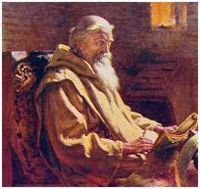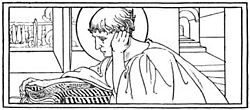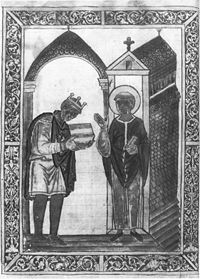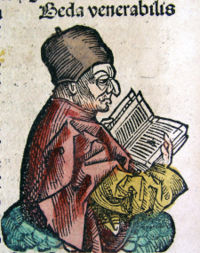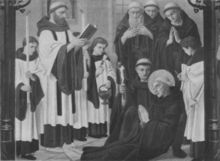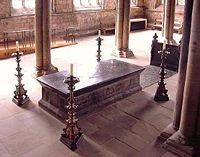Bede
2008/9 Schools Wikipedia Selection. Related subjects: British History 1500 and before (including Roman Britain); Historians, chroniclers and history books
| The Venerable Bede | |
|---|---|
|
'The Venerable Bede translates John' J. D. Penrose (ca. 1902) |
|
| Doctor of the Church | |
| Born | ca. 672, Jarrow, Northumbria |
| Died | 25 May 735, Jarrow, Northumbria |
| Venerated in | Roman Catholic Church, Eastern Orthodox Church, Anglican Communion, Lutheran Church |
| Canonized | 1899 recognised as Doctor of the Church, Rome by Pope Leo XIII |
| Major shrine | Durham Cathedral, Northumbria. |
| Feast | 25 May |
| Patronage | English writers and historians; Jarrow |
Bede (IPA: /ˈbiːd/) (also Saint Bede, the Venerable Bede, or (from Latin) Beda (IPA: [beda])), (c. 672 or 673 – May 25, 735), was a Benedictine monk at the Northumbrian monastery of Saint Peter at Monkwearmouth, today part of Sunderland, and of its companion monastery, Saint Paul's, in modern Jarrow (see Wearmouth-Jarrow), both in the Kingdom of Northumbria.
He is well known as an author and scholar, and his most famous work, Historia ecclesiastica gentis Anglorum (The Ecclesiastical History of the English People) gained him the title "The father of English history". Bede is regarded as a Doctor of the Church by the Roman Catholic Church, a position of theological significance, he is the only man from Great Britain to achieve this designation.
Name
Bede became known as Venerable Bede (Lat.: Beda Venerabilis) soon after his death, but this was not linked to consideration for sainthood by the Roman Catholic Church. In fact, his title is believed to come from a mistranslation of the Latin inscription on his tomb in Durham Cathedral, intended to be Here lie the venerable bones of Bede, but wrongly interpreted as here lie the bones of the Venerable Bede.
Life
Almost everything that is known of Bede's life is contained in a notice added by himself when he was 59 to his Historia (Book V, Chapter 24), which states that he was placed in the monastery at Wearmouth at the age of seven, that he became deacon in his nineteenth year, and priest in his thirtieth. He implies that he finished the Historia at the age of 59, and since the work was finished around 731, he must have been born in 672/3. It is not clear whether he was of noble birth. He was trained by the abbots Benedict Biscop and Ceolfrid, and probably accompanied the latter to Wearmouth's sister monastery of Jarrow in 682. There he spent his life, prominent activities evidently being teaching and writing, the two of most interest to him. There he also died, on May 25, 735, and was buried, although his body was later transferred to Durham Cathedral.
Work
His works show that he had at his command all the learning of his time. It was thought that the library at Wearmouth-Jarrow was between 300-500 books, making it one of the largest and most extensive in England. It is clear that Biscop made strenuous efforts to collect books during his extensive travels.
Bede's writings are classed as scientific, historical and theological, reflecting the range of his writings from music and metrics to exegetical Scripture commentaries. He was proficient in patristic literature, and quotes Pliny the Elder, Virgil, Lucretius, Ovid, Horace and other classical writers, but with some disapproval. He knew some Greek, but no Hebrew. His Latin is generally clear and without affectation, and he was a skillful story-teller. However, his style can be considerably more obscure in his Biblical commentaries.
Bede's scriptural commentaries employed the allegorical method of interpretation and his history includes accounts of miracles, which to modern historians has seemed at odds with his critical approach to the materials in his history. Modern studies have shown the important role such concepts played in the world-view of Early Medieval scholars.
Historia Ecclesiastica
The most important and best known of his works is the Historia ecclesiastica gentis Anglorum, giving in five books and 400 pages the history of England, ecclesiastical and political, from the time of Caesar to the date of its completion (731). The first twenty-one chapters, treating of the period before the mission of Augustine of Canterbury, are compiled from earlier writers such as Orosius, Gildas, Prosper of Aquitaine, the letters of Pope Gregory I and others, with the insertion of legends and traditions. After 596, documentary sources, which Bede took pains to obtain throughout England and from Rome, are used, as well as oral testimony, which he employed with critical consideration of its value. He cited his references and was very concerned about the provenance of his sources, which created an important historical chain.
Bede's use of something similar to the anno Domini era, created by the monk Dionysius Exiguus in 525, throughout Historia Ecclesiastica was very influential in causing that era to be adopted thereafter in Western Europe. Specifically, he used anno ab incarnatione Domini (in the year from the incarnation of the Lord) or anno incarnationis dominicae (in the year of the incarnation of the lord). He never abbreviated the term like the modern AD. Unlike the modern assumption that anno Domini was from the birth of Christ, Bede explicitly refers to his incarnation or conception, traditionally on March 25. Within this work, he was also the first writer to use a term similar to the English before Christ. In book I chapter 2 he used ante incarnationis dominicae tempus (before the time of the incarnation of the lord). However, the latter was not very influential—only this isolated use was repeated by other writers during the rest of the Middle Ages. The first extensive use of 'BC' (hundreds of times) occurred in Fasciculus Temporum by Werner Rolevinck in 1474, alongside years of the world (anno mundi).
Other historical and theological works
Bede lists his works in an autobiographical note at the end of his Ecclesiastical History. He clearly considered his commentaries on many books of the Old and New Testaments as important; they come first on this list and dominate it in sheer number. These commentaries reflect the biblical focus of monastic life. "I spent all my life," he wrote, "in this monastery, applying myself entirely to the study of Scriptures." Bede’s poem “The Great Forerunner of the Morn,” written originally in Latin and translated into English by renowned hymn translator John Mason Neale in 1854, is still sung today as a hymn set to various tunes.
As Chapter 66 of his On the Reckoning of Time, in 725 Bede wrote the Greater Chronicle (chronica maiora), which sometimes circulated as a separate work. For recent events the Chronicle, like his Ecclesiastical History, relied upon Gildas, upon a version of the Liber pontificalis current at least to the papacy of Pope Sergius I (687-701), and other sources. For earlier events he drew on Eusebius's Chronikoi Kanones. The dating of events in the Chronicle is inconsistent with his other works, using the era of creation, the anno mundi.
His other historical works included lives of the abbots of Wearmouth and Jarrow, as well as lives in verse and prose of Saint Cuthbert of Lindisfarne. In his Letter on the Death of Bede, Cuthbert, monk and later Abbot of Jarrow, describes Bede as still writing on his deathbed, working on a translation into Old English of the Gospel of John and on Isidore of Seville's On the Nature of Things.
Scientific writings
The noted historian of science, George Sarton, called the eighth century "The Age of Bede"; clearly Bede must be considered as an important scientific figure. He wrote several major works: a work On the Nature of Things, modeled in part after the work of the same title by Isidore of Seville; a work On Time, providing an introduction to the principles of Easter computus; and a longer work on the same subject; On the Reckoning of Time, which became the cornerstone of clerical scientific education during the so-called Carolingian renaissance of the ninth century. He also wrote several shorter letters and essays discussing specific aspects of computus and a treatise on grammar and on figures of speech for his pupils.
On the Reckoning of Time ( De temporum ratione) included an introduction to the traditional ancient and medieval view of the cosmos, including an explanation of how the spherical earth influenced the changing length of daylight, of how the seasonal motion of the Sun and Moon influenced the changing appearance of the New Moon at evening twilight, and a quantitative relation between the changes of the Tides at a given place and the daily motion of the moon. Since the focus of his book was calculation, Bede gave instructions for computing the date of Easter and the related time of the Easter Full Moon, for calculating the motion of the Sun and Moon through the zodiac, and for many other calculations related to the calendar. He gives some information about the months of the Anglo-Saxon calendar in chapter XV. Any codex of Bede's Easter cycle is normally found together with a codex of his "De Temporum Ratione".
For calendric purposes, Bede made a new calculation of the age of the world since the Creation. Due to his innovations in computing the age of the world, he was accused of heresy at the table of Bishop Wilfred, his chronology being contrary to accepted calculations. Once informed of the accusations of these "lewd rustics," Bede refuted them in his Letter to Plegwin.
His works were so influential that late in the ninth century Notker the Stammerer, a monk of the Monastery of St. Gall in Switzerland, wrote that "God, the orderer of natures, who raised the Sun from the East on the fourth day of Creation, in the sixth day of the world has made Bede rise from the West as a new Sun to illuminate the whole Earth".
Vernacular poetry
According to his disciple Cuthbert, Bede was also doctus in nostris carminibus ("learned in our songs"). Cuthbert's letter on Bede's death, the Epistola Cuthberti de obitu Bedae, moreover, commonly is understood to indicate that Bede also composed a five line vernacular poem known to modern scholars as Bede’s Death Song
- And he used to repeat that sentence from St. Paul “It is a fearful thing to fall into the hands of the living God,” and many other verses of Scripture, urging us thereby to awake from the slumber of the soul by thinking in good time of our last hour. And in our own language,—for he was familiar with English poetry,—speaking of the soul’s dread departure from the body:
| Facing that enforced journey, no man can be More prudent than he has good call to be, |
Fore ðæm nedfere nænig wiorðe ðonc snottora ðon him ðearf siæ |
As Opland notes, however, it is not entirely clear that Cuthbert is attributing this text to Bede: most manuscripts of the letter do not use a finite verb to describe Bede's presentation of the song, and the theme was relatively common in Old English and Anglo-Latin literature. The fact that Cuthbert's description places the performance of the Old English poem in the context of a series of quoted passages from Sacred Scripture, indeed, might be taken as evidence simply that Bede also cited analogous vernacular texts. On the other hand, the inclusion of the Old English text of the poem in Cuthbert’s Latin letter, the observation that Bede "was learned in our song," and the fact that Bede composed a Latin poem on the same subject all point to the possibility of his having written it. By citing the poem directly, Cuthbert seems to imply that its particular wording was somehow important, either since it was a vernacular poem endorsed by a scholar who evidently frowned upon secular entertainment or because it is a direct quotation of Bede’s last original composition.
Manuscript tradition
There are two surviving manuscripts written within a few years of Bede's death:
- St Petersburg Bede
- Cambridge University Library MS.
After this, there is a gap of some 50 years. Manuscripts written before AD 900 include:
- Corbie MS, Bibliotheque Nationale, Paris
- St. Gall Monastery Library
Copies are sparse throughout the 10th century and for much of the 11th century. The greatest number of copies of Bede's work was made in the 12th century, but there was a significant revival of interest in the 14th and 15th centuries. Many of the copies are of English provenance, but also surprisingly many are Continental. Bede's collected works were published in Patrologia Latina vols. 90-95, but this edition was "bad on a monumental scale, and included more spuria than any previous edition".
Palatine Library:
- De natura rerum {CPL 1343} [685]/1
- De tabernaculo {CPL 1345} [245]/1
- Commentarius in Parabolas Salomonis {CPL 1351} [759]/1
- In Marci evangelium expositio {CPL 1355} [247]/1
- In Lucae evangelium expositio {CPL 1356} [242], 1ra-157va. excerpts , passim
- Super epistolas catholicas expositio {CPL 1362} [246], 1r-80r. [947], 92r-99r {RB 1639: Beda abbrev.}. excerpt (prologue to 2.Ioh.) , 8ra
- Homilies {CPL 1367} , passim; [563], passim. Hom. I 3 [193], 258ra-vb (exc.); hom. I 8 [193], 166ra-vb (exc.); hom. I 9 [193], 164rb-165ra (exc.); hom. I 12 [193], 177va-179ra; hom. I 15 [193], 174ra-175vb
- Liber hymnorum {CPL 1372} Hymnus 1 [809]/4
- De schematibus et tropis {CPL 1567} [345]/1 (exc.)
- De temporibus liber {CPL 2318} [685]/2
- De temporum ratione {CPL 2320} [685]/3
Veneration
Pilgrims were claiming miracles at Bede's grave only fifty years after his death. His body was transferred to Durham Cathedral in the mid-11th century and to its present location in the Galilee Chapel there in 1370. It is likely that his remains are authentic. Other relics were claimed by York, Glastonbury and Fulda.
His scholarship and importance to Catholicism were recognised in 1899 when he was declared the only English Doctor of the Church as St Bede The Venerable. He is also the only Englishman in Dante's Paradise ( Paradiso' X.130), mentioned among theologians and doctors of the church in the same canto as Isidore of Seville and the Scot Richard of St. Victor.
